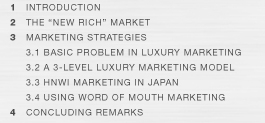the market for HNWIs in Japan, that can be tapped by both foreign and Japanese
luxury companies (Interview were conducted with Andreas Dannenberg, CEO of
AdComm [28.03.2008], Takaoka Soichiro, CEO of Abraham-Holdings [01.04.2008],
Yamada Yu, CEO of Ypsilon Group [17.03.2008] and Tsuchiya from KT Marketing
[25.03.2008]). The key lies in entering the social networks of HNWIs. By
accessing opinion leaders specific to their own product category luxury
companies can become more sensitive to future trends and faster than the
competitors to react to social changes. Communication with the most important
customers can prove to be an invaluable tool for customer segmentation,
profiling, networking, and “influencing the patronage behavior of dozens, hundreds, even thousands of
affluent prospects” (Stanley 1993: 1).
For luxury companies the advice should be: See the connection between your own
customers and possible prospects and understand the complexity of word of mouth
as it is spreading through networks. The 'satisfied customer' and the
'influential professional' who experienced an innovative event today, could
turn into your brand advocates at the dinner party tomorrow, even if they are
not your customers yet. Go where your customer target groups are, make your
presence known, become part of their lives, and create "conversations" about
your products. Accept the fact that brand equity builds up over time through
the authenticity of your communication, which is constantly evaluated within
social networks. And most importantly: communicate with luxury consumers. Try
to listen to their conversations—about your brand, your competitors, and your product category.
Yamada Yu, CEO from the Ypsilon Group offers wealthy customers what they want: a
better life, more time, amusement, and a social environment where they can
demonstrate their sophistication and taste. Added value is the keyword, but it
does not necessarily have to come from inside the company. Instead, it can be
achieved by collaborations with service partners, and the association with
people from other fields such as within arts and culture, within nightlife, and
other social networks—in short: influential people who
“produce” the cultural setting of today's complex scene of professional and private
interactions. Studies about these “cultural creatives” or the “creative class” and the socioeconomics of metropolises are the subject of many recent studies,
including Currid (2007), Scott (2008), and Chadha and Husband (2006), the
latter describing how to create “the spin” (buzz) and “the cult” of a luxury brand. Marketers start to realize that culture is more than a mere
by-product of economic activity, but is strongly inter-connected with market
forces in the premium segment, and that understanding these dynamics can prove
invaluable. This and the recent emergence of CSR and SRC (social responsible
consumption) are not only current trends that will pass within a few years.
They are a look into the future of marketing where “relevance, simplicity, and humanity—not technology” are the distinguishing elements of brands in the future (Bedbury 2002: 183).
Stanley (1993: ix) gives a good summary: “[...] where do you and your offerings rank in the eyes of important patronage
opinion leaders? Encourage these leaders to rank you high. Cultivate their
endorsements. Become a vital part of their influence networks. Without their
support, you may be assigned a small piece of the affluent market.”
Being a young market, there are no empirical studies available on the
effectiveness of HNWI marketing strategies, probably due to the difficulty in
acquiring exact data on HNWI customers. Research should continue in these areas
to produce relevant and reliable knowledge for marketers involved in the field
of HNWI research. Topics could include: How is the information transferred
within HNWI networks, and who are the opinion leaders? It would also be
interesting to find out which networks have the most influence in specific
industries, how the flow of information is transferred, and what relation
exists between event marketing and the spread of product information. Investing
into research for creative solutions on how this flow of information can be
influenced and controlled should become a central issue for luxury companies.

The commodification of luxury has left the upper class frustrated, realizing
that their old status markers have lost part of their appeal. Therefore
marketing to this social elite has to take into account their desire to feel
special, to feel exclusive, and to be separated from the crowd of mass luxury
consumers. This kind of “super-elitization” will make brands target the upper classes with exquisite handcrafted pieces and
individualized versions made in limited numbers—“hand-made artisanal value” for the “genuinely affluent and genuinely educated” (Joanne Ooim, creative director of Shanghai Tang, printed in Chadha and Husband
2006: 284)—that again allow the social elite to distance themselves from the consumer rich
who are buying the lower segment versions of their favorite brands and
products. Also, a selection of sophisticated shoppers who are bored by the
standardized offerings of mass luxury are now looking for the excitement of
discovering something out of the ordinary. “A lot of people want to go to places where there are nicer little finds. Now it
[existing retail] is so predictable ... it has lost the spark, it's
anaesthetized” (Chadha and Husband 2006: 284).
Luxury companies have to bring back its “spark”, the aesthetic component of shopping. They need to realize that channels are
different in the premium market, more exclusive, and sometimes even blocked
from direct access. The higher the consumer level, the more sophisticated the
approach has to be. The needed market intelligence can often only be provided
by third-party companies who have made extensive connections within social
networks and offer databases of HNWIs, as well as creative solutions to reach
them indirectly. The services introduced in section 3.3 do not necessarily
exclude each other. All of the solutions offered points to gaining access to
HNWI customers, but by using different channels and reaching different customer
segments.
Interviews conducted with each of the companies' CEOs revealed one common fact
upon which all of them could agree: there is still a huge potential in
